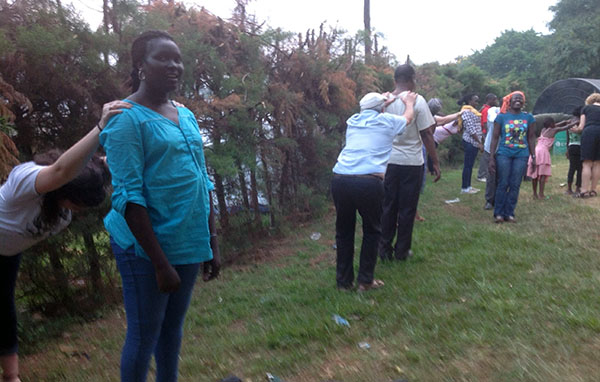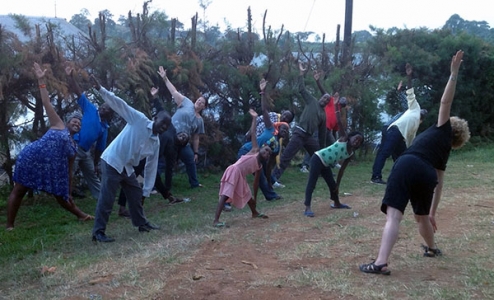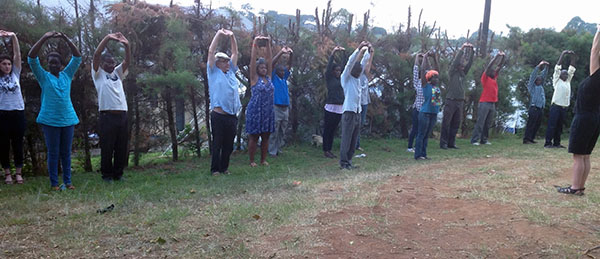On Wednesday December 17th 2014, after an exhausting bus ride on bumpy, dusty, and unpaved roads, we finally reached Kyaka II. We were traveling to this refugee settlement in western Uganda as part of the Equator Peace Academy’s (EPA) two-week program “Coping with Refugees in a Foreign Land,” which was devoted to the refugee question. With time before dinner and tired from the long hours in the bus, members of our group requested that I lead a yoga session.
After doing a few Urdhva Hastasana, Badangulyiasana, Utthitha Trikonasana poses,[1] the group became aware that two young girls from the refugee camp behind me were copying our moves. With a big smile, we invited them to join us. They were soon followed by a six-year-old boy. These little children all beamed with joy to be practicing with the grownups, just as their presence infused tremendous joy into our session. We did not need to communicate in any other way; yoga became our common language.
Feeling the togetherness and the joy, I decided on the spot that after almost two weeks together, the group was ready to try some partner work. As one person became a wall, his or her partner adopted a modified Adho Mukha Svanasana.[2] The children worked together. Both partners benefited from the stretch: one stood in Tadasana,[3] while the other gently lowered the trapezius muscles on entering into the modified pose. We then graduated to a modified partner Utthita Trikonasana and Virabharadasana II.[4] We felt a wonderful sense of togetherness. Practicing with these little children from the refugee camp brought energy and a sense of purpose; it was one of those moments when we touch grace.
This practice time in Kyaka II with the small children was the culmination of our yoga work. Almost every day we had learned basic asanas for 30 minutes. I was amazed to see how quickly the group, the majority of whom were from East Africa, the United States, and Canada and had no prior yoga experience, took to the yoga practice sessions. Many expressed their surprise at the power of these simple movements, which helped them center and let go of stress after a full day of activities.
At the beginning of the program we scheduled yoga practice every two or three days, but as people asked for more, we added sessions whenever possible. Yoga proved most helpful after long trips, which is how we came to practice together with the children in camp Kyaka II. Yoga brought us together in a fundamental way. As one participant observed, “we had fun, we could laugh together, and it also rejuvenated us.” In addition to giving us the power to bring our group of strangers together, yoga enabled us to reconnect to our bodies after emotional and intellectual activities. Integrating our bodies and mind reinvigorated each of us and nurtured our togetherness.
The EPA is an affiliate program of the global educational network CEDAR (Communities Engaging with Difference and Religion), where I am the staff member in charge of reflective practice. In our programs throughout the years, yoga has become part of our methodology, one of the different containers created to engage the whole person. This methodology, created by CEDAR and implemented in Uganda by the EPA, focuses on learning together how to engage with our differences. For more than 12 years we have developed programs that integrate the many ways in which we humans learn, creating an awareness of how we see strangers and the baggage we bring to these meetings. Lectures, site visits, and facilitation sessions in which we personalize our learning prompt participants to connect with their deep-seated assumptions regarding strangers.
As CEDAR’s program grew, I gradually started sharing my passion for yoga with our group participants. Iyengar yoga in particular supports my efforts toward reflective practice. One of the first things I tell each CEDAR group is that in meeting our “others,” we must become aware of our assumptions and act, not react. We need to stop and become aware. In a way this approach is like the yogic principle of Svadayaya, self-study. Only through stopping and feeling can we understand our own bodies’ reactions when we encounter strangers. How can we encounter our “others” if we are not seated in our bodies and aware of our own reactions?
I remember the first time, in Bosnia in 2004, when some joined in my daily practice after a very tense day, exhausted by the sheer destruction we had encountered in Mostar. Without words, we pushed the chairs away and created a space for opening our chests and ourselves to life again. Since then, I have brought my love for yoga to each different yearly group. Organically, yoga has grown in my own life as well as in our programs and has become an integral part of our routine. In our CEDAR groups, yoga has the power to bring us together, to experience joy, but also to accomplish the difficult task of bringing our bodies into sync with our minds. Meeting strangers and our differences can be scary at times, and yoga also teaches us to confront our boundaries, the places where we are afraid. Achieving the integration of body, mind, and soul is a lifelong process, but we take a small step toward it during these programs. In yoga as well as in the rest of the program, we practice with the group to face up to our places of discomfort as we encounter difference.
I am always humbled to see people who, during these two weeks, start the process of returning to their bodily sensations in a very methodical way and find these difficult places. They become aware of their body parts and the places where they hold tension, discomfort. Participants love the new feelings of openness, as well as the realization that these simple movements are actually not so simple. The feeling of well-being that comes at the end of a practice is indeed well earned. While we enjoy the process, we also meet with our boundaries, as we do in our groups. Yoga is one way we bump up against our physical boundaries. Sometimes, we learn that these boundaries are not set in stone, and that we can push through our discomfort to find a new way to engage not only our bodies, but also the stranger among us. Yoga has proved itself a most valuable ally in this process. It teaches us to look at our boundaries, the places where we are afraid. As we learn to face our own bodily sensations and feelings in yoga, we become conscious of the social boundaries within our groups and learn to confront them too. Both in our yoga practice and in our encounters with strangers, we have begun the work of learning to live with discomfort and difference.
Rahel Wasserfall is the CEDAR Director of Evaluation and Training and a Scholar in Residence at the Women’s Studies Research Center (WSRC) at Brandeis University.
Notes
[1] Upward hands pose, upward bound fingers pose, triangle pose
[2] Dog pose
[3] Mountain pose
[4] Warrior II pose












I was so humble to be a part of an interesting team like EPA 2014 Uganda. The memories I gathered will be always be a big part of me for a life time through.
Learning how to live with in my space and crossing boundaries was something my heart cherished the most and this brought a clear understanding of who I truly I am.
The greatest lesson I took home with me during Yoga practices was that; “Most answers to the questions I so ask for are right there within me, if I just reconnected and listened to my body, heart, soul and mind”.
Those two weeks will always live with me as each season unfolds.
Thanks a lot Rachel for this write up. Having joined the EPA team in your Yoga sessions, I must admit that they are worth and a good methodology for building a cohesive team. We freely mixed irrespective of class, academic, religious, gender and racial backgrounds.
At the end, we had great fun but also refreshed the body, mind and soul. I recall Yoga at L.Victoria Munyonyo on the beach, so wonderful you were and Monica.
Much as I work and live alone far in Asia, I now break the boredom with yoga and feel connected with the inner me and a peace of mind.
Thanks for all and hope to meet once again.
Dear Evelyne and Moses,
Thanks for these words, I am really happy that you find the practice worthwhile. I have so many fond memories of our work together, it sustains me in these days of intense cold in New England, where the snow keeps falling, Good wished to each one of you, I do hope we will meet again somewhere in the world and practice together.
Time flies, or does it?
Well, it does, in an exam. It doesn’t, when you want EPA III (2016) to ‘arrive’ tomorrow, Wednesday 18 February 2015. For, I am already in the mood of another cohesive family, as Moses urges us to say. Yet I realize, Uganda shall have to brave election fever, at least, before EPA III arrives! It is Rahel, whose live and lively piece has left me sentimental. Look, there is the yoga session, on arrival at Kyaka II. Abbas cannot believe he was as flexible as an “iron bar.” Yet actually, he is one reason I would want to see the sessions up sooner.
“Let the little children come to me,” so said the Good Book. I will ask Ajay, could you kindly drop-in-the-box the little boy and two girls, or was it, that joined the fray?
“Yoga on the Road in Uganda” is lovely piece of message. It is beyond an article. Many thanks, Rahel, for making us relive the events, the message behind the sessions, and the call to action behind the fellowship. This is an early reminder, of the year’s commitments thereof.
“Baruch ata Adoshem, elokenu melech ha olam, asher natan l’ashvi binah l’haudil ben yom v’ben lailah,” as learned during a break time in-between session with Adam.
Cheers,
Vinsensiyo
Dear Vincent,
Thanks for these kind words. We indeed did a thorough job of bumping into our boundaries and were able to meet others without erasing their differences. I made some strong connections. I also took my understanding and my yoga teaching to another level, so thank you Vincent and all EPA fellows.
I cannot wait to come back and meet you all again, Rahel
What wonderful work you are doing with your yoga and the CEDAR program. I loved reading this essay and felt touched by it in many ways. What a beautiful experience for all involved. Congratulations on the valuable work you are doing!
We also enjoyed yoga in Indonesia and it is a practice that I have learn to take seriously since the days you taught us. Last in India, I enjoyed it as well, when we had yoga sessions after a tiresome day. It really refreshes and is a good destresser.
I must thank Rahel for Yoga; it made us one. I will never forget the expression ‘open your legs, fix, enter and release….’; the touching of the wall; the chair exercise, etc. It was a wonderful experience which I will live with everyday as an East African-Ugandan-Rwandan. The photos at Kyaka II are painted afresh in my mind and make me reflect on living together in a foreign land…. Let us keep the CEDAR/EPA spirit alive….